|
FAQs About Turtle Identification 2
Related Articles: Turtles, Shell
Rot in Turtles, Amphibians,
Red Eared Slider Care,
FAQs on: Turtle Identification 1, Turtle ID 3, Turtle ID
4,
Related FAQs: Turtles 1, Turtles 2, Red Ear
Sliders, Turtle Behavior,
Turtle Compatibility, Turtle Selection, Turtle Systems, Turtle Feeding, Turtle Disease, Shell Rot, Turtle Reproduction, & by Species:
Musk/Mud Turtles, Softshells, Snapping Turtles, Mata Matas, Tortoises, & Amphibians, Other
Reptiles,
|

|
|
Turtle identification 10/10/09
Hello :)
<Hello,>
A friend of my daughter's found this turtle in the woods. I
already scolded him for taking it from its habitat, but now
I'm not sure what to do with it.
<Generally best to release it where found, as soon as
possible. Ideally, contact your local Fish & Wildlife
department to see if a park ranger can take you to an optimal
release site away from things like busy roads.>
I am wondering if I should take it to the pet store even though
my daughter wants to keep it.
<Certainly shouldn't take it to a pet store. For one
thing, wild animals can catch diseases from pet animals, and
_vice versa_. On the other hand, staff at a good reptile and
amphibian store may well know something about the reptiles local
to your bit of the world.>
He is rather small (about as big as the palm of my hand) and the
bottom of his shell is a bit soft.
<Appears to be an Eastern Box Turtle, Terrapene carolina. This
is a highly variable species, but the dome-like shell, brown
colour, and hooked beak are characteristic. The front of the
lower shell is hinged, so when the head is pulled back, a
trapdoor closes off that part of the shell. Males have red eyes,
females brown. I'm assuming you're in the United States
somewhere, where this is species is _by far_ the most common
terrestrial turtle (what here in England we'd call a
tortoise).>
He has a short neck, dark eyes and the bit of yellow colorings
that I can see. seem to be much darker at times and DO appear
much brighter in photos.
<If the eyes are brown, and this is Terrapene carolina, then
"he" is a she.>
He is currently in a large bird cage which we have attempted to
convert for his needs. (Frisbee filled with water, dirt for
burrowing, half of a potters pot for shelter and
"hiding" etc.
<Wild-caught specimens don't especially well in captivity,
though you have covered the key things, particularly water. They
like to bathe, but the water shouldn't be so deep (or the
bowl so steep around the edges) it cannot get out easily. If it
gets through the first few weeks, and eats and drinks normally,
the species can last a long time in captivity. High humidity is
important. Bear this in mind if you decide to keep this animal;
kept properly, it'll outlive you! The record for a wild
specimen is 138 years, and between 50-100 years seems fairly
common. In captivity you can expect upwards of 30 year lifespans,
and up to 60 years has been reported.
Like all reptiles, you need to provide a heat source of some sort
if you do not plan to hibernate the animal. Generally,
hibernating reptiles is tricky unless you have fattened them up
carefully beforehand, and I'd recommend against it, at least
for the first year. The heat source of choice is a lamp, and it
should be one that produces UV-B as well as heat, because they
need UV-B to synthesise Vitamin B1 and convert calcium into bone
and shell.
In short: they need a big vivarium, a bathing pool, a source of
heat, and a source of UV-B. This will be fairly expensive to pull
together, and while there's no rush, you will need to have
all these bits and pieces before it starts getting too cold. In
the wild your Box Turtle would be looking for a resting place to
hibernate, somewhere cool, dry, secure from predators and safe
from flooding. If you want to keep your turtle, you're going
to have to provide a warm, humid alternative.>
He moves very quickly and seems to be quite smart lol. (He found
a way out of the cage within a few minutes of putting him in it
and we were thankful we were there to see it or we never would
have believed it - it's fixed now. - and he already prefers
one shelter corner over the other!).
<Shelter is indeed very important. It's also critical to
make sure predators, particularly pet dogs, can't get into
the cage. Even a "playful" dog could wound or kill a
Box Turtle.>
I have attached some photos and am very curious to know what kind
of turtle he is, how old, gender etc. and most importantly what
he should be eating and what I should do with him.
<As I said, likely Terrapene carolina, probably female if the
eyes are brown rather than red. Age difficult to say; seems to be
full grown, so could be anything from 10 to 100 years!>
we've tried many types of food (lettuce, bugs, cooked eggs,
cooked pork, fruit etc. - so far he seems to prefer the eggs and
pork but only ate each of those once along with a small bit of
cucumber. He seems to eat one day but not the next.
<Avoid "meat", i.e., anything from a warm blooded
animal. The fats in these foods coagulate inside the turtle,
causing problems. Instead opt for mostly greens, romaine lettuce
and curly lettuce being ideal. Augment with soft fruit (melon,
tomato, berries) and offer small amounts of things like
earthworms, mealworms, and white fish. Very occasionally you can
offer them cooked chicken bones, which seem to go down well, but
not too often.>
Thanks in advance for your help.
Brenda
<If you plan to keep this animal, do spend some time reading
up on keeping Eastern Box Turtles in captivity. There are some
excellent reptile books available for pet owners, and one of
those would be a sound investment.
Keeping reptiles in captivity isn't easy, and not something
to do on a whim. It's a shame to capture an animal that can
live for 100 years in the wild, and then kill it after a few
months through neglect. So, make your choice: buy all the stuff
it needs to thrive, or else return the animal from whence it
came, ideally after calling the local wildlife bureau in your
neighbourhood. Hope this helps. Cheers, Neale.>
|
 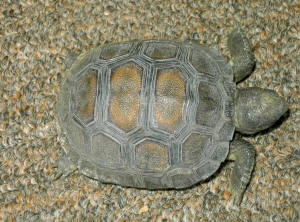 |
Re: turtle identification
10/10/09
Thank you so much for a speedy reply.
<My pleasure.>
Based on your information, we have decided it would be most fair to
this little lady if we called our local wildlife bureau and let her
have her chance to live to a ripe old age.
<Good move.>
You have been most helpful.
PS - we Live in Florida, USA. Although we are a very warm and humid
state, we do have our cold days in winter so she would still need
much care.
<Air temperature all year around should be fine if this animal
was kept indoors in a room that wasn't air conditioned. The
main thing is to avoid extremes of heat and coldness; anything
between 15-30 C should be fine, assuming it has access to water (to
keep cool) and a basking lamp (to warm up). But there's no
getting around the fact reptiles are all expensive pets in terms of
setting up their habitat, even though compared to cats and dogs
their long term costs are low (they don't eat much; kept
properly, rarely get sick; and don't need such procedures as
neutering). Still, they're not pets for everyone. Cheers,
Neale.> |
|
Care of a 2 in. alligator snapping turtle
9/30/09
Hi,
<Hiya - Darrel here>
My granddaughter found a small black turtle with a beak and spiny
back on September 26 in the middle of a barrier beach of Smith
Point County Park on Fire Island, Suffolk County New York. My
husband had spotted a similar turtle a few days earlier in the
middle of the camp ground road and he moved it to the marshy area
on the bayside of the barrier beach. We feel we rescued it but
want to know what to do now!
<That would be a long way out of the range of an alligator
snapping turtle, but within the normal range of a common snapper,
Barbara. Alligator snappers are common only to the drainage basin
around the Mississippi river. Assuming there's no chance that
it's an escaped pet or even a sea turtle (Sea turtles have
flippers and no claws)?? What I'd really like at this point
is a couple of photos, even if just from a phone camera. Face,
side and from front & above would help clear up a number of
questions>
We have it in a clear plastic container with wet beach sand, a
clump of wet kelp and a sea sponge and a clam shell to provide
habitat and a receptacle for fresh water and food.
<None of those would be common environment of either snapping
turtle>
We offered bits of cooked chicken ,chopped meat and lettuce at
different times without much interest.
<Based on it's environment it probably is in no mood,
maybe even no condition to eat>
It has been active at times, climbing to the top of the sponge
but is mostly burrowed into a thin layer of sand under the kelp.
Aside from removing the old food and 'poop' and
occasionally peeking under things to assure that it is alive we
haven't disturbed it much. Now the question: is it keepable
as a pet for an 8 year old under supervision, or should we
release it and where?
<Well whether or not it's keepable is dependent on a great
number of question unanswered. Snapping turtles are notorious for
biting hard and having short tempers, so they don't make a
good lap pet. But with that said, even a Red Eared Slider can
inflict a nasty bite if handled incorrectly -- so really it all
depends on the level of maturity of the 8 year old. Turtles are
good pets to house, care for and observe, but not to play
with.>
<As far as the other thing ... NO!!! NO!!! We never EVER
release any animal into the wild, even when it's with our
best intentions.
Territories, sub species, communicable diseases ... just a few of
a hundred reasons. If he survived at all, he'd possibly
contaminate others, so we never ever release into the
wild.>
<Once we find out what it is -- send pics!!! -- we'll
decide what to do.
In the mean time, the link below will give you some basic
information.>
<All snapping turtles are more aquatic than sliders. While
they do it less often, they DO haul out & bask and still need
a warm dry place to soak up some UV rays ... so for the purpose
of the time being only, read the enclosed link and set up a basic
environment to specifications. Meanwhile send pics and we'll
go from there>
Any help or advise you can give would be most appreciated!
Sincerely Grandma
< http://www.wetwebmedia.com/FWSubWebIndex/RESCareBarton.htm>
Re: care of a 2 in. alligator snapping turtle
9/30/09
Hi Barbara,
Yes, what you have there is the Common Snapping turtle, Chelydra
serpentina. They make interesting pets but frankly they are a bit
dangerous. The rules for keeping a snapping turtle are that you
never, ever, ever ... for any reason .... put anything you care
about anywhere near the front half of that animal. They're
not actually mean ... but they have a very limited tolerance for
anything moving around in front of their face before they'll
strike out at it -- and once they grab a solid hold, they have
the ability to hang on for very long periods.
A 20 gallon aquarium (or similar container) with shallow water
(no deeper than 4 inches) and a small place to haul out and dry
off under a basking light is all that is required initially. If
it's not an actual aquarium, make sure the sides are high
enough that it can't climb. Feeding is simple -- ReptoMin
food sticks or Koi Pellets from the local pet store (same
ingredients, just cheaper) will provide a fully balanced
diet.
They're interesting, low maintenance pets but on the other
hand, they're very hardy animals that, with even minimal
care, can grow to an extremely dangerous size in just a few
years. So my advice on keeping it? ...
maybe .. maybe not. But if you decide not, inquire around your
city for a turtle and tortoise club to find someone with the
desire and experience and please just don't release it.
Best wishes
Darrel
|
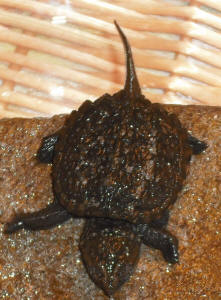 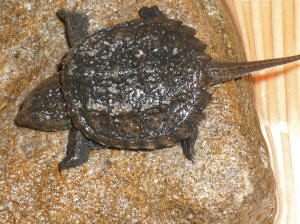 |
|
Turtle identification 8/18/09
Hello,
<Hiya!>
I'm Lotoya
<I'm not! -- I'm Darrel>
I'm just trying to identify the type of turtle that I have.
Based on the receipt I received from the pet shop, it states that
its a red ear slider.
However, based on photos that I have found on the internet, it
looks more like a yellow bellied slider, So I am just trying to
confirm this with you guys.
<Based on the lack of a bright red patch on the side of the
head, generally around where we'd expect ears to be (hence
the name Red "Eared" Slider as opposed to Red
"Necked" Slider), this is indeed a one of any number of
subspecies of Trachemys Scripta scripta, or Yellow Bellied
Slider.>
<Of course, if he sits around the house all day chewing
tobacco, has a broke down pickup truck in his front lawn and a
refrigerator on his front porch .... HE JUST MIGHT BE a REDNECK
Yellow Bellied Slider!!!!!!>
PS I have attached two photographs.
<Larry is handsome>
Thanks in advance for your help.
<Here's some more help: a Complete Guide to caring for
Larry:
http://www.wetwebmedia.com/FWSubWebIndex/RESCareBarton.htm>
Regards,
Lotoya
|
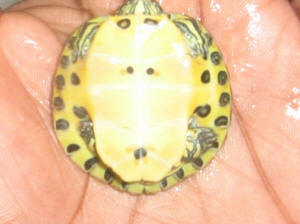 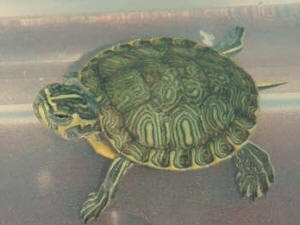 |
Turtle Identification 7/14/2009
Can you all identify this baby turtle for me?
<Yeah -- I think his name is Gary.>
<He might be a baby Box turtle (Terrapene) or any one of a
number of Emydid (water) turtles. The problem is that the straight
on top angle gives us just a vague outline. We can tell he's
not a mud, musk, soft-shell or snapping turtle. Not a Tortoise or a
sea turtle. He's not a Clydesdale Horse either, but I suspect
you already figured that out.>
<What I'd really like is a couple of face shots and one from
the side.
Not glamour shots of course, no hair or makeup needed .. just a
better angle to see his distinct features.>
<Unless you mean that OTHER thing .... that's not a turtle
at all, that's a quarter!>
<Regards - Darrel> |
 |
|
what kind of turtle and how old is it
6/27/09
I know the attached is not a snapping turtle but I have never
seen anything this big that was not, what is it and how old.
<It's a Common Snapping Turtle (Chelydra serpentina).
Alligator Snapping Turtles (Macrochelys temminckii) generally
have a row of spikes along the midline of the shell running along
the spine, whereas Common Snapping Turtles do not. As for age, I
have no idea. Captive specimens routinely live well over 20
years, and the record is around twice that. Given the apparent
size of this specimen, it is probably going to be well over ten
years old.>
found in the Metro North Parking lot, in June, 2009 land put on
side of road and let go. /Westchester County, NY
<Cheers, Neale.>
|
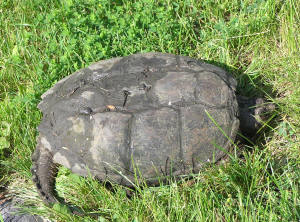 |
Re: what kind of turtle and how old
is it 6/27/09
I would never have guessed a snapping turtle. Thank you for your
very prompt reply. John H Vargo, Publisher, Boatingonthehudson.com
and boating on the Hudson & beyond mag.
<Happy to help. Cheers, Neale.> |
|
What kind of turtle is this? 4/30/09
My little girl found this turtle while fishing and wanted to keep
it. I would like to know what kind it is so I can give it the
proper care it needs.
<Hello James. The photos are too blurry to be able to tell
anything much, but it would appear to be a Slider of some sort,
Trachemys spp. So the basic requirements are not much different
to the popular Red-ear Slider, as outlined here:
http://www.wetwebmedia.com/FWSubWebIndex/RESCareBarton.htm
Now, before you give in to your daughter, think about how much it
costs to keep one of these. Most Sliders are big and messy,
eventually dinner plate-sized animals that need aquaria around 55
gallons in size, if not larger. Beside the tank, you'll need
a big external canister filter just to keep the water clean and
safe; without it, the water will become cloudy as well as toxic.
Minimum, you want a filter rated at 6 times the volume of the
tank in turnover per hour; for a 55 gallon system, that's 330
gallons per hour. So, the filter and the aquarium are already
setting you back the best part of $200. Next up is a heater (yes,
you'll need one, because the turtle won't be able to
hibernate in captivity when room temperature drops.
Without a heater, it will quickly become plagued with respiratory
tract infections that require care from your vet, not to mention
all the other problems reptiles succumb to when they're cold.
As if this wasn't enough, you'll also need a basking
lamp, specifically a UV-B lamp, without which the turtle will
rapidly become sick. It needs UV-B to perform certain chemical
reactions associated with bone and shell formation, among other
things. All told, you're going to be spending several hundred
dollars.
Because turtles grow rapidly, a smaller tank now (say, a 20
gallon system) would need to be upgraded within a couple of
years. Finally, there's diet: turtles can't be maintained
on "turtle food" from the pet shop, at least, not
entirely. You need to augment their diet on a regular basis
(i.e., every week) with fresh green foods. While not expensive,
quite the contrary in fact, this underlines the fact that Sliders
aren't "easy" pets. They're difficult to keep,
expensive, and around children at least, potentially hazardous
because Salmonella and other bacteria grow easily in their
habitats (especially if said habitat isn't kept clean!). They
aren't
especially pretty when they mature (most become fairly dull
green, and the yellow colour you see now will fade away) and
certainly have no interest at all in being handled. What I'm
trying to tell you is that you should stop and think EXTREMELY
carefully before taking on the burden of a pet turtle.
Much better to observe this animal in the wild -- where it
belongs, frankly -- and enjoy it for what it is, a wild animal.
Then maybe go with your daughter to a pet shop or book shop, buy
a book about keeping pet reptiles, and then decide if you, as a
family, are prepared to create a home for these admittedly
fascinating animals. Cheers, Neale.>
|
  |
|
|

